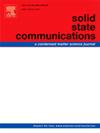Study of interfacial engineering on exchange bias effect in NiO/CoFe2O4 heterostructures
IF 2.4
4区 物理与天体物理
Q3 PHYSICS, CONDENSED MATTER
引用次数: 0
Abstract
In the present work, the magnetic properties of NiO/CoFe2O4 (CFO) bilayers, grown via pulsed laser deposition on Si (100) substrates, have been investigated. The NiO layer thickness has been varied to explore its effect on the structural, magnetic, and electronic properties of the studied bilayer. Structural characterization of the studied compound has been analyzed using X-ray diffraction, X-ray reflectivity, atomic force microscopy, and Raman spectroscopy. An exchange bias effect has been observed in the studied bilayer, and interestingly, it varies with the thickness of the NiO layer due to the formation of an intermixed layer at the NiO/CFO interface. Furthermore, soft X-ray absorption spectroscopy (SXAS) measurement has also been carried out to study the electronic structure, and the obtained data corroborate well with its structural results. The relationship between the thickness of NiO with exchange bias can be understood through the enhanced interfacial exchange coupling between the CFO and NiO layers.
NiO/CoFe2O4异质结构中交换偏置效应的界面工程研究
本文研究了脉冲激光沉积法在Si(100)衬底上生长的NiO/CoFe2O4 (CFO)双层膜的磁性能。通过改变NiO层厚度来探索其对所研究双层结构、磁性和电子性能的影响。用x射线衍射、x射线反射率、原子力显微镜和拉曼光谱分析了所研究化合物的结构特征。在所研究的双层中观察到交换偏置效应,有趣的是,由于在NiO/CFO界面处形成了混合层,交换偏置效应随NiO层厚度的变化而变化。此外,还进行了软x射线吸收光谱(SXAS)测量,对其电子结构进行了研究,所得数据与结构结果吻合较好。通过CFO和NiO层之间增强的界面交换耦合,可以理解NiO厚度与交换偏置之间的关系。
本文章由计算机程序翻译,如有差异,请以英文原文为准。
求助全文
约1分钟内获得全文
求助全文
来源期刊

Solid State Communications
物理-物理:凝聚态物理
CiteScore
3.40
自引率
4.80%
发文量
287
审稿时长
51 days
期刊介绍:
Solid State Communications is an international medium for the publication of short communications and original research articles on significant developments in condensed matter science, giving scientists immediate access to important, recently completed work. The journal publishes original experimental and theoretical research on the physical and chemical properties of solids and other condensed systems and also on their preparation. The submission of manuscripts reporting research on the basic physics of materials science and devices, as well as of state-of-the-art microstructures and nanostructures, is encouraged.
A coherent quantitative treatment emphasizing new physics is expected rather than a simple accumulation of experimental data. Consistent with these aims, the short communications should be kept concise and short, usually not longer than six printed pages. The number of figures and tables should also be kept to a minimum. Solid State Communications now also welcomes original research articles without length restrictions.
The Fast-Track section of Solid State Communications is the venue for very rapid publication of short communications on significant developments in condensed matter science. The goal is to offer the broad condensed matter community quick and immediate access to publish recently completed papers in research areas that are rapidly evolving and in which there are developments with great potential impact.
 求助内容:
求助内容: 应助结果提醒方式:
应助结果提醒方式:


